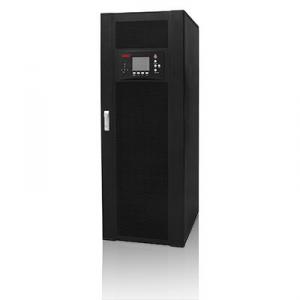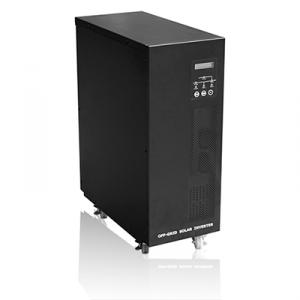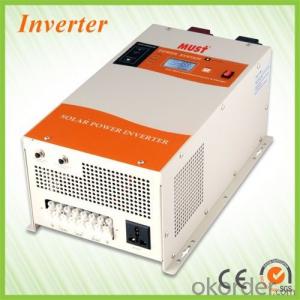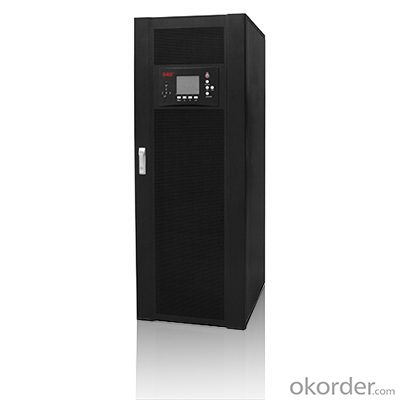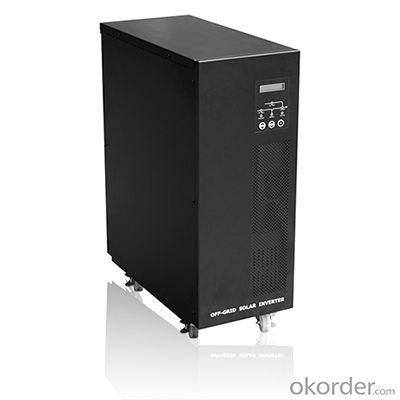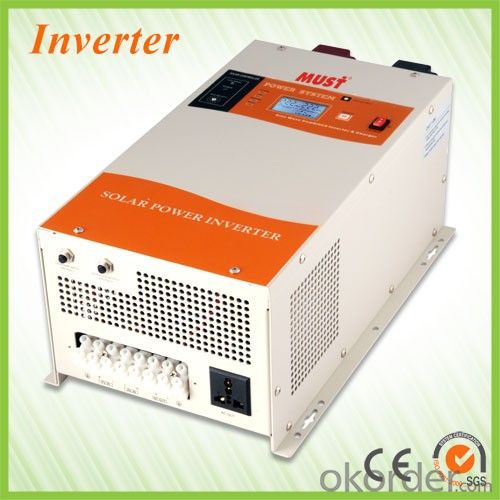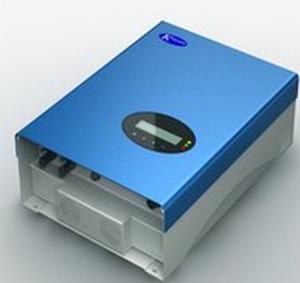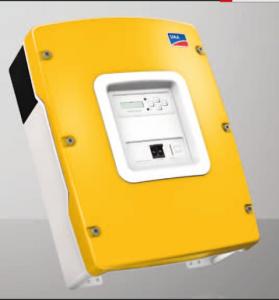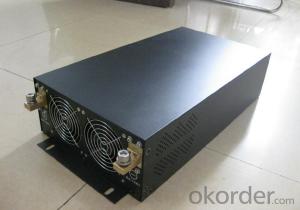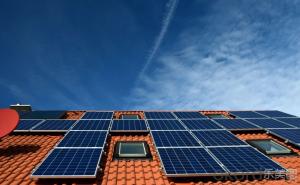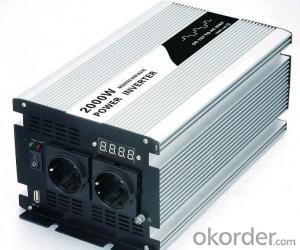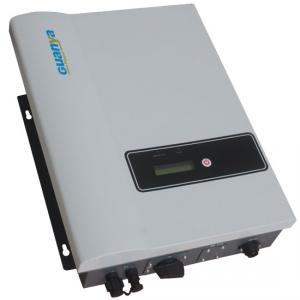Solar Inverter for Sale - Off-Grid Solar Inverter 10kVA-120kVA Made in China High Intelligence
- Loading Port:
- China main port
- Payment Terms:
- TT or LC
- Min Order Qty:
- 1 pc
- Supply Capability:
- 1000 pc/month
OKorder Service Pledge
OKorder Financial Service
You Might Also Like
Off-Grid Solar Inverter 10KVA-120KVA
EA-GF series products use high speed DSP control unit, advanced high speed IGBT, MOSFET components, with pulse width modulation (SVPWM) technique disturbance type MPPT control, and double conversion system configuration. Under high-speed DSP system control, the system can quickly track panels to do high-power, load change and efficient multi-level control system, even if the mains input voltage and frequency suddenly change, over/under voltage, or power disturbances, it also can ensure provide the load with regulated voltage and frequency power. System has a reliable, environmentally friendly, high intelligence and other characteristics.
Villa, hotel, residential security, large base station, office, small manufacturing enterprises, computing centers, industrial automation equipment, network room, IDC data center, banking equipment, securities, health care, transportation, petrochemical and other solar systems.
● High reliability:
※ High-speed micro-controller DSP digital control technology to achieve real-time control, parameter setting, data detection, self-test function to ensure high reliable operation of the system.
※ With high speed switching characteristic, high voltage, high current, low internal resistance, low dissipation IGBT, MOSFET power components based, to ensure system security and reliability.
● N+1 modularized MPPT tracking system:
※ Multipath MPPT control system access, independent input, operation. More suitable for roof project, to improve power generation efficiency of the panels.
● PV proactive power supply function:
After detects PV energy, system will enter MPPT status automatically, and it will also adjust the power distribution, priority in the use of PV energy.
● Intelligent battery management system:
※ In this system, AC rectifier 、MPPT controller controlled by intelligent data exchange and communication system,user can set the battery capacity by themselves;battery configuration can be set by the operator interface,system will automatically
adjust the charging current ,charging voltage and charging mode.
※ In special cases,international technical engineer can adjust the charging rate and battery number according to the system configuration.
● Plenteous communication interface:
※ RS485、RS232 (standard),SNMP(Option).
※ Input dry contacts to switch on/off inverter, clear abnormal, EPO remotely. Output dry contacts singles for remote alarm.
● Intelligent storage staggering features:
System with intelligent peak load shifting function, the user can set the appropriate time period electricity according to the local electricity policy, to achieve load shifting features directly in order to bring economic value;
Model | 10KVA | 20KVA | 30KVA | 40KVA | 50KVA | 60KVA | 80KVA | 100KVA | 120KVA | |
Rated Power(KW) | 9KW | 18KW | 27KW | 36KW | 45KW | 54KW | 72KW | 90KW | 108KW | |
Rated Current (A) | 15A | 30A | 45A | 60A | 76A | 91A | 133A | 151A | 182A | |
Output Power Factor | 0.9 | |||||||||
Rated Input Voltage | 380V±20% | |||||||||
Rated Output Voltage | 380V±1% | |||||||||
Battery Voltage | 360Vdc | |||||||||
Battery Quantity | 30 units, 12V | |||||||||
Working Mode | PV、AC replenish | |||||||||
PV Input | Max Voltage | 750Vdc | ||||||||
Best Working Voltage(Vmp) | 444-550Vdc | |||||||||
Float Charging Voltage | 414V±1% | |||||||||
Max Efficiency | ≥98% | |||||||||
Equalize Charging Voltage | 428V±1% | |||||||||
Max Current | 40A | 60A | 120A | 180A | 240A | 300A | 360A | |||
PV Input Ways | 1+1(reserved) | 2+1(reserved) | 3+1(reserved) | 4+4(reserved) | 5+3(reserved) | 6+2(reserved) | ||||
MPPT Modular | 1+1(reserved) | 2+1(reserved) | 3+1(reserved) | 4+4(reserved) | 5+3(reserved) | 6+2(reserved) | ||||
AC Rectifier | Input Voltage Range | Three phases 380V ±20%(-10%~+20% can charge the battery) | ||||||||
Rated Frequency | 50 Hz / 60Hz(can be set backstage) | |||||||||
Frequency Range | 50Hz/60Hz±5Hz | |||||||||
Soft Start | 0-100% 10s | |||||||||
Power Factor | 0.8 | |||||||||
Float Charging Voltage(20℃) | 410V±1% | |||||||||
Max Voltage | 415V±1% | |||||||||
Max Charging Current(A) Battery Capacity Allowed | 12 | 25 | 38 | 50 | 62 | 75 | 80 | 100 | 120 | |
Inverter | Inverter Voltage | Three phases four lines +G 380Vac | ||||||||
Phase Voltage Setting | 220-230-240Vac(can be set backstage) | |||||||||
Output Voltage Accuracy | ±1% | |||||||||
Voltage Transients Range | ±5% | |||||||||
Transient Recovery Time | 20ms | |||||||||
Rated Frequency | 50Hz/60Hz±1% | |||||||||
Frequency Tracking Range | 50Hz/60Hz±3Hz | |||||||||
Crest Factor | 3:1 | |||||||||
Wave | Pure sine wave | |||||||||
THD | ≤3%(linear load) | |||||||||
Voltage Unbalance Degree | ±3%(100%unbalance load) | |||||||||
Overload | ≥105%-110%: transfer to bypass 1 hours later, recover when reduce load ≥110%-125%: transfer to bypass10 min later, recover when reduce load ≥125%-150%: transfer to bypass 1 min later, recover when reduce load ≥150%: transfer to bypass 10 s later, recover when user confirmed ≥200%: shutdown immediately, recover when user confirmed | |||||||||
Short Circuit | System current limited, shut down immediately, boot by user | |||||||||
Max Efficiency % | ≥90% | ≥91% | ≥92% | ≥92% | ≥93% | ≥93% | ≥93% | ≥93% | ≥93% | |
Bypass | Rated Voltage(V) | Three phases four lines+G 380Vac | ||||||||
Voltage Range | ±20% | |||||||||
Rated Frequency(Hz) | 50/60Hz±5Hz | |||||||||
Max Current | 19 | 38 | 57 | 76 | 95 | 114 | 122 | 152 | 182 | |
Battery Management | End of Discharge | 315VDC | ||||||||
Charging Current Setting | Factory setting is 0.15C10 ; user can set 0.05-0.3 C10 | |||||||||
Charging Current Setting | Equalizing charging and float charging automatically transfer, automatic temperature compensation for battery (when battery detection not connected, default environment temperature) | |||||||||
Staggering Depth of Discharge Settings | 1.85V-2.1V; can be set by user | |||||||||
Transfer Time | Inverter/Bypass Transfer Time | 0ms | ||||||||
Inverter/Bypass Transfer Time | 0ms | |||||||||
Communication Interface | Remote Control Input | Inverter on、off、abnormal clear、emergency power off | ||||||||
PC Monitoring Interface | RS232、RS485、SNMP (optional) | |||||||||
Dry Contact | Bypass input abnormal、rectifier input abnormal、system fault、system warning、 low battery、overload 、fans fault、generator ON/OFF | |||||||||
Environment | Operation Temperature | 0-42℃ | ||||||||
Max. Relative Humidity | 90% (non condensed) | |||||||||
Max. Working Altitude | 1000m (100 m higher, 1% derated; max 4000m) | |||||||||
Other | Cooling Way | Forced ventilation (Fans speed varies with the load) | ||||||||
Noise(1m varies with load and temperature )dB | 65 | |||||||||
Mean Time Between Failures(MTBF) | 200,000 hours | |||||||||
Defend Grade(EN60529) | IP20 | |||||||||
Power Line Input | Bottom | |||||||||
Standard | IEC62040-1-1、EN62109-1:2010, EN62109-2:2011 | |||||||||
Dimensions(WxDxH)mm | 600×700×1750 | 1000×800×1700 | ||||||||
Packing Dimensions(WxDxH)mm | 690×790 ×1850 | 1090×890 ×1800 | ||||||||
Weight | 250 | 280 | 300 | 320 | 345 | 360 | 400 | 420 | 445 | |
· Q. What is an UPS and What it is for ?
An uninterruptible power supply (UPS) is a device that allows your computer or telephone switch or critical equipement to keep running for at least a short time or longer time when the primary power source is lost. It also provides protection from power surges, spikes, brownouts, interference and other unwanted problems on the supported equipment.
· Q. How long the UPS to run when power goes?
This can take 3 paths.
1.You can pick a UPS that is rated for pretty much the full VA you need so it will be running at 100% of capability and will thus last 'n' minutes.
2.You can pick a UPS that is rated at a much higher VA value than you really need so, for example, is running at 50% of capability and will thus last for longer than the UPS from option 1.
3.You can use extra external battery packs to run for longer. If charging capability allows, the more and the bigger batteries you take with, the longer time UPS runs.
or using a generator after about 6 hours, it will be more cost-effective, with a short runtime UPS to bridge the generator start-up gap.
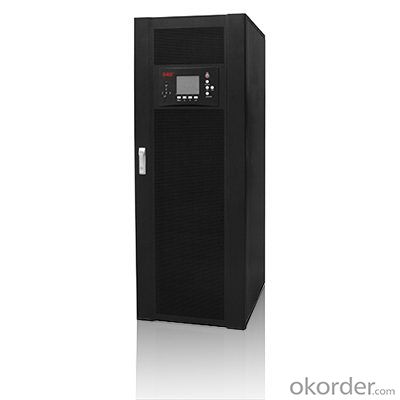

- Q: What is the role of a bypass switch in a solar inverter?
- The role of a bypass switch in a solar inverter is to provide an alternate path for the solar energy to flow in case of a fault or failure in the inverter. It allows the solar power to bypass the inverter and directly feed into the grid or another designated load, ensuring continuous power supply and preventing any disruptions in the system.
- Q: Can a solar inverter be used in areas with high dust and dirt accumulation?
- Yes, it is possible to use a solar inverter in areas where there is a high accumulation of dust and dirt. However, it is important to take specific precautions and maintenance measures to guarantee its proper operation. Over time, dust and dirt can build up on the surface of the solar panels, causing a decrease in their efficiency. This can also have an impact on the performance of the solar inverter, as it relies on the energy produced by the solar panels. To minimize the impact of dust and dirt, it is essential to regularly clean the solar panels. This can be accomplished by using a gentle brush or sponge along with a mild detergent mixed with water. It is important to avoid using abrasive materials or applying excessive water pressure, as this may cause damage to the panels. Additionally, installing the solar panels at an angle and orienting them towards the sun can aid in reducing the accumulation of dust and dirt. Furthermore, some solar inverters are designed with built-in protection against dust and dirt. These inverters typically have IP65 or higher ratings, which indicates that they are dust-resistant and capable of withstanding water jets. Opting for such inverters can provide an extra layer of protection against the negative effects of dust and dirt accumulation. Overall, while it is possible to use a solar inverter in areas with high dust and dirt accumulation, regular maintenance and proper cleaning of the solar panels are crucial to ensure optimal performance and longevity of the system.
- Q: Can a solar inverter be used with dual MPPT inputs?
- Yes, a solar inverter can be used with dual MPPT (Maximum Power Point Tracking) inputs. This feature allows the inverter to optimize and extract maximum power from two separate solar arrays or panels. By using dual MPPT inputs, the inverter can handle variations in shading, orientation, or different panel specifications, thereby maximizing the overall energy production and efficiency of the solar system.
- Q: Can a solar inverter be used with different types of grid support functions?
- Yes, a solar inverter can be used with different types of grid support functions. Solar inverters are designed to convert the direct current (DC) produced by solar panels into alternating current (AC) that can be fed into the electrical grid. They can be configured to provide various grid support functions such as reactive power control, voltage and frequency regulation, and anti-islanding protection. These functions allow solar inverters to actively support the stability and reliability of the grid, regardless of the specific requirements of the grid system.
- Q: What is the role of voltage regulation in a solar inverter?
- The role of voltage regulation in a solar inverter is to ensure that the energy generated by the solar panels is converted and delivered to the electrical grid or used within a premises at a stable and appropriate voltage level. It helps to maintain the quality and consistency of the electricity output, protecting the connected devices and ensuring optimal performance of the solar power system.
- Q: What is the role of a DC-DC converter in a solar inverter?
- The role of a DC-DC converter in a solar inverter is to convert the direct current (DC) generated by the solar panels into the appropriate voltage level required for the inverter to convert it into alternating current (AC) electricity. This conversion ensures efficient power transfer from the solar panels to the grid or for use in residential or commercial applications.
- Q: What is the role of MPPT (Maximum Power Point Tracking) in a solar inverter?
- The role of MPPT (Maximum Power Point Tracking) in a solar inverter is to optimize the efficiency and output of the solar panel system. MPPT technology enables the inverter to constantly track and adjust the operating point of the panels, ensuring that they are operating at their maximum power point, where the highest power output is achieved. This allows the system to capture the maximum amount of energy from the sun, maximizing the overall efficiency and performance of the solar inverter.
- Q: How does a solar inverter affect the overall efficiency of a solar system?
- A solar inverter plays a crucial role in the overall efficiency of a solar system. It converts the direct current (DC) generated by solar panels into alternating current (AC) that can be used to power household or commercial appliances. By ensuring optimal conversion efficiency and minimizing power losses during this process, a high-quality solar inverter can significantly impact the overall efficiency of a solar system.
- Q: Can a solar inverter be used with a net metering system?
- Yes, a solar inverter can be used with a net metering system. A solar inverter is an essential component of a solar power system as it converts the direct current (DC) generated by solar panels into usable alternating current (AC) electricity. Net metering allows for the excess electricity produced by the solar panels to be fed back into the grid, resulting in credit or compensation from the utility company. The solar inverter facilitates this process by ensuring that the electricity generated by the solar panels is synchronized with the grid, allowing for seamless integration and net metering.
- Q: What is the maximum AC power output of a solar inverter?
- The maximum AC power output of a solar inverter varies depending on the specific model and capacity. It can range from a few hundred watts for small residential inverters to several megawatts for large commercial or utility-scale inverters.
Send your message to us
Solar Inverter for Sale - Off-Grid Solar Inverter 10kVA-120kVA Made in China High Intelligence
- Loading Port:
- China main port
- Payment Terms:
- TT or LC
- Min Order Qty:
- 1 pc
- Supply Capability:
- 1000 pc/month
OKorder Service Pledge
OKorder Financial Service
Similar products
Hot products
Hot Searches
Related keywords
